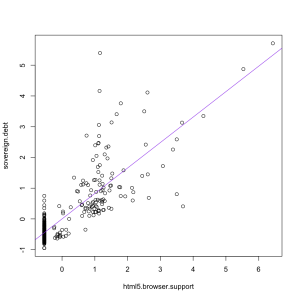The denominator problem shows up yet again, this time in a press release from AA insurance, leading to stories in the Dominion Post, the Herald, the Aucklander, and probably others, and a Stat of the Week nomination for the Groping Towards Bethlehem blog (via Eric Crampton).
There are statistical problems in the press release, but the newspapers came up with additional bonus examples.
The press release says
Between 2009 and 2011 AA Insurance received the highest number of burglary and theft from vehicle claims from Auckland, Hamilton, Wellington, and Christchurch.
and the Dominion Post amplifies this to
But Wellingtonians were far less likely to be burgled than their Auckland counterparts, with 31 per cent of all burglaries taking place in the Auckland region, compared with just under 9 per cent in Wellington.
Auckland has three times as many burglaries as Wellington, which sounds bad until you consider that Auckland is larger than Wellington, by a factor of about, um, three. Using population at the last census, the rate of burglaries per capita is still higher in Auckland, but by only 20%. If we compare Auckland to the whole population of New Zealand, the burglary rate per capita is slightly lower in Auckland; and since the Wellington rate is lower, if we combine Auckland and Wellington the rate is also lower than for the rest of the country. This tends to cast doubt on the comment
AA Insurance head of operations Martin Fox said daytime robberies were more common in big cities, where most people did not head home for lunch.
This could be true if night-time burglaries[I assume he means burglaries, not robberies] were much more common outside big cities, but we aren’t given any data to support this, and the data we do have argues against it.
So far this is mostly fluff, but the interesting bit of news is
Security alarms had proven effective for preventing burglaries, with 60 per cent of claims between 2009-11 coming from homes without alarm systems.
AA Insurance presumably know how many of their customers have security alarms, so they might have evidence for this claim. Perhaps only 30% of insured homes lack alarm systems, so the 60% of claims from such homes is notable. We can’t tell, because they don’t explicitly give any comparisons of rates, they don’t give information that we could use to compute rates, and they sure haven’t given us any reason to trust them on the handling of denominators.
If we did have rates, there would still be a problem of causation vs correlation. A Ministry of Justice survey in 2004 did find lower rates of burglary in houses with alarms, but they also found
The security measure most strongly associated with lowered rates of burglary was ‘telling neighbours when everyone will be away’. As only a small proportion of burglaries occurred while the occupants were away (Section 6.5.1), presumably this measure was an indicator for a more general relationship, such as a lowered risk of burglary when neighbours are known and when neighbours look out for one another.

